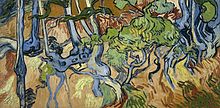|
Tree Roots
Tree Roots is an oil painting by Vincent van Gogh that he painted in July 1890 when he lived in Auvers-sur-Oise, France.[1][2] The painting is an example of the double-square canvases that he employed in his last landscapes.[3] BackgroundVan Gogh spent the last few months of his life in Auvers-sur-Oise, a small town just north of Paris, after he left an asylum at Saint-Rémy in May 1890.[4] The painting is considered by some to be his last painting before his death late July 1890.[Works 1] Jan Hulsker considers it the most original of his double-square canvases. The viewer thinks he can identify tree roots and trunks, but is hard put to identify the subject as a whole.[3] Van der Veen and Knapp comment that in this painting, as also in Undergrowth with Two Figures, the painting itself and not the subject is pre-eminent, heralding abstract painting and German expressionism.[5] In 1882, while at The Hague, van Gogh had made a study of tree roots, Study of a Tree (below), which he had completed at the same time as a larger version (now lost) of Sorrow. In a letter to his brother Theo, van Gogh said that he wanted to express something of life's struggle in these drawings.[Letters 1] It is not known whether he had returned to the same thoughts with his 1890 Tree Roots. The letters give no hint and the colours are perhaps too bright for such sombre thoughts.[Works 1]  On April 14, 1991 Tree Roots was stolen from the Van Gogh museum along with 19 other paintings. Tree Roots was successfully recovered.[6] In 2020, Wouter Van der Veen, scientific director of Institut Van Gogh determined the probable location where the painting was made, based on an historical postcard, to be on the rue Daubigny in Auvers-sur-Oise.[7] He confirmed his finding with a historical photograph from circa 1907 in 2021. The location is about 150 metres from Auberge Ravoux, Van Gogh's hotel at the time.[8]
See alsoWorks
Letters
References
Bibliography
External links
|
||||||||||||||||||



